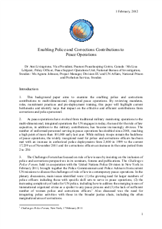BACKGROUND PAPER Enabling Police and Corrections Contributions to Peace Operations

As peace operations have evolved from traditional military monitoring operations to the multi-dimensional, integrated operations the United Nations (UN) engages in today, the need for the rule of law capacities, in addition to the military contributions, has become increasingly obvious. While military troops remain the backbone of peace operations, the widely recognized need for police and corrections officers has been met with an increase in authorized police deployments from 2,400 in 1999 to the current 17,239 as of November 2011 and for corrections officers an increase in the same period from 2 to 250.
The Challenges Forum has focused on rule of law issues by insisting on the inclusion of police and corrections perspectives in its seminars, forums and publications. Addressing the need for all aspects of the justice chain to be included in peace operations is not a new idea. The Report of the Panel on United Nations Peace Operations (also known as the ‘Brahimi report’) is often referenced as the starting point for including justice and corrections as an integral part to rule of law in peace operations. It stated that a greater effectiveness among the host country’s police may, in fact, be diminished if there is not a correspondingly enhanced capacity in the associated areas of the judiciary and corrections.
This paper aims to examine the enabling police and corrections contributions to multi-dimensional, integrated peace operations. By reviewing mandates, roles, recruitment practices and pre-deployment training, this paper will highlight current bottlenecks and identify ways that impact on the effective and efficient contributions from corrections and police personnel.

